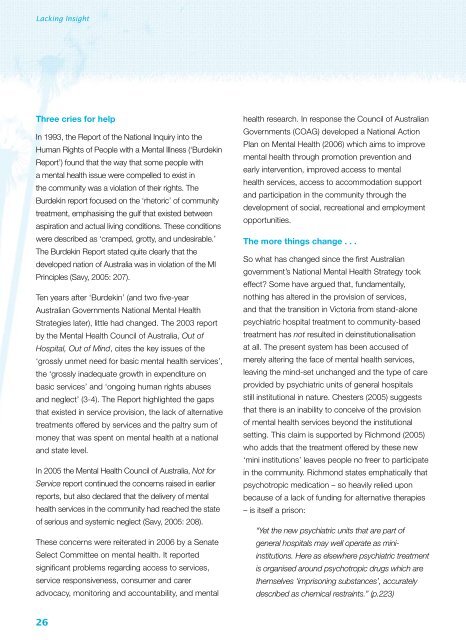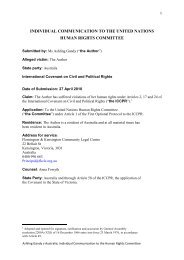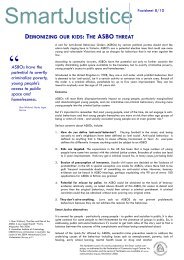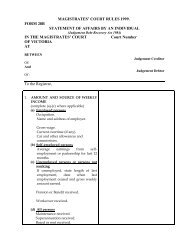Lacking Insight - Community Law
Lacking Insight - Community Law
Lacking Insight - Community Law
- No tags were found...
You also want an ePaper? Increase the reach of your titles
YUMPU automatically turns print PDFs into web optimized ePapers that Google loves.
<strong>Lacking</strong> <strong>Insight</strong>Three cries for helpIn 1993, the Report of the National Inquiry into theHuman Rights of People with a Mental Illness (‘BurdekinReport’) found that the way that some people witha mental health issue were compelled to exist inthe community was a violation of their rights. TheBurdekin report focused on the ‘rhetoric’ of communitytreatment, emphasising the gulf that existed betweenaspiration and actual living conditions. These conditionswere described as ‘cramped, grotty, and undesirable.’The Burdekin Report stated quite clearly that thedeveloped nation of Australia was in violation of the MIPrinciples (Savy, 2005: 207).Ten years after ‘Burdekin’ (and two five-yearAustralian Governments National Mental HealthStrategies later), little had changed. The 2003 reportby the Mental Health Council of Australia, Out ofHospital, Out of Mind, cites the key issues of the‘grossly unmet need for basic mental health services’,the ‘grossly inadequate growth in expenditure onbasic services’ and ‘ongoing human rights abusesand neglect’ (3-4). The Report highlighted the gapsthat existed in service provision, the lack of alternativetreatments offered by services and the paltry sum ofmoney that was spent on mental health at a nationaland state level.In 2005 the Mental Health Council of Australia, Not forService report continued the concerns raised in earlierreports, but also declared that the delivery of mentalhealth services in the community had reached the stateof serious and systemic neglect (Savy, 2005: 208).These concerns were reiterated in 2006 by a SenateSelect Committee on mental health. It reportedsignificant problems regarding access to services,service responsiveness, consumer and careradvocacy, monitoring and accountability, and mentalhealth research. In response the Council of AustralianGovernments (COAG) developed a National ActionPlan on Mental Health (2006) which aims to improvemental health through promotion prevention andearly intervention, improved access to mentalhealth services, access to accommodation supportand participation in the community through thedevelopment of social, recreational and employmentopportunities.The more things change . . .So what has changed since the first Australiangovernment’s National Mental Health Strategy tookeffect? Some have argued that, fundamentally,nothing has altered in the provision of services,and that the transition in Victoria from stand-alonepsychiatric hospital treatment to community-basedtreatment has not resulted in deinstitutionalisationat all. The present system has been accused ofmerely altering the face of mental health services,leaving the mind-set unchanged and the type of careprovided by psychiatric units of general hospitalsstill institutional in nature. Chesters (2005) suggeststhat there is an inability to conceive of the provisionof mental health services beyond the institutionalsetting. This claim is supported by Richmond (2005)who adds that the treatment offered by these new‘mini institutions’ leaves people no freer to participatein the community. Richmond states emphatically thatpsychotropic medication – so heavily relied uponbecause of a lack of funding for alternative therapies– is itself a prison:“Yet the new psychiatric units that are part ofgeneral hospitals may well operate as miniinstitutions.Here as elsewhere psychiatric treatmentis organised around psychotropic drugs which arethemselves ‘imprisoning substances’, accuratelydescribed as chemical restraints.” (p.223)26
















